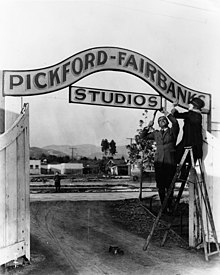Samuel Goldwyn Studio
34°05′22″N 118°20′47″W / 34.089575°N 118.346475°W
 Entrance to The Lot at Formosa | |
| Company type | Film studio |
|---|---|
| Predecessor | United Artists |
| Fate | Folded into Warner Bros. and Metro-Goldwyn-Mayer |
| Successor | Metro-Goldwyn-Mayer |
| Headquarters | West Hollywood, California |
Key people | Mary Pickford Douglas Fairbanks Samuel Goldwyn |

Samuel Goldwyn Studio was the name that Samuel Goldwyn used to refer to the lot located on the corner of Formosa Avenue and Santa Monica Boulevard in West Hollywood, California, as well as the offices and stages that his company, Samuel Goldwyn Productions, rented there during the 1920s and 1930s. At various times, the location was also known as Pickford–Fairbanks Studios, the United Artists Studio, Warner Hollywood Studios, and its name since 1999, The Lot at Formosa.[1]
History
[edit]Originally controlled by independent producer Jesse D. Hampton, the site was acquired by Mary Pickford and Douglas Fairbanks and dubbed Pickford–Fairbanks Studios in 1919.[2] It was later renamed the United Artists Studio in 1928, as it was being used by several independent producers, including Samuel Goldwyn, that distributed through United Artists. Although Goldwyn did not control the deed for the land, he and Joseph Schenck built many of the facilities on the lot.[3]
Schenck left United Artists in 1935, leaving his share of the deed to Goldwyn, and Fairbanks died in 1939, leaving his share to Pickford. When Goldwyn left United Artists in 1940, he sought to rename the lot Samuel Goldwyn Studio. Pickford and Goldwyn fought over the name and ownership of the property until a court ordered that the lot be auctioned in 1955.
James Mulvey, Goldwyn's most trusted business confidant and president of Samuel Goldwyn Inc., outbid Pickford for the property.[4] The lot officially became Samuel Goldwyn Studio and remained so until Warner Bros. purchased the site in 1980, naming it Warner Hollywood Studios.[5]
Warner Bros. sold the property in 1999, and the name was officially changed to its longtime nickname, The Lot at Formosa. In 2012, the owners demolished several of the Pickford and Goldwyn era buildings and replaced them with new buildings.
Awards
[edit]The sound department of the studio was awarded with the Academy Award for Best Sound for the film In the Heat of the Night (1967).[6]
See also
[edit]- Formosa Cafe
- Goldwyn Pictures
- Metro-Goldwyn-Mayer
- United Artists
- Samuel Goldwyn Productions
- The Samuel Goldwyn Company
- Samuel Goldwyn Films
- Samuel Goldwyn Television
References
[edit]- ^ "The Lot (formerly Warner Hollywood Studios)". Seeing-stars.com. Retrieved 2011-04-01.
- ^ "Pickford–Fairbanks Studios". Silentgents.com. Archived from the original on 2011-05-14. Retrieved 2011-04-01.
- ^ "Samuel Goldwyn: Hollywood's Lone Wolf". Cobbles.com. Retrieved 2011-04-01.
- ^ "The Lot: A legendary studio of independent production in classic Hollywood". Cobbles.com. Retrieved 2011-04-01.
- ^ "WARNER HOLLYWOOD STUDIOS GENERAL INFORMATION". Replay.waybackmachine.org. 2009-06-03. Archived from the original on June 3, 2009. Retrieved 2011-04-01.
{{cite web}}: CS1 maint: unfit URL (link) - ^ "The 40th Academy Awards (1968) Nominees and Winners". oscars.org. Retrieved 2011-08-25.

